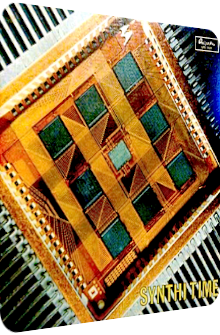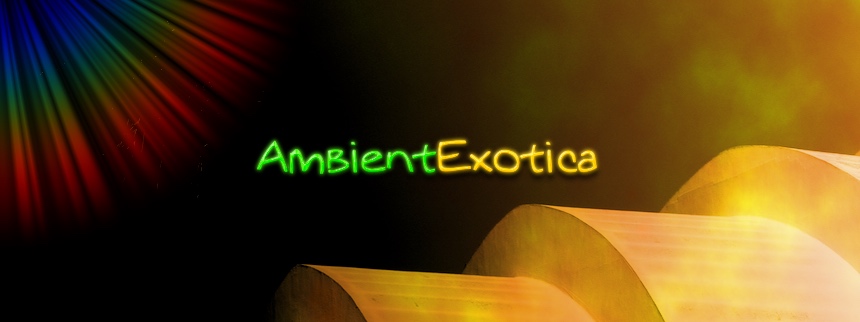
Piero Umiliani
Synthi Time
1971
Composer and film buff Piero Umiliani (1926–2001) has never shied away from ostensibly reducing his true powers in order to bring listeners debonair delight… and experimental weirdness. The many library music scores are of great interest to Exotica and Space-Age aficionados and outshine their filmic pendants more often than not. After all, gemstones and travelogs such as Musica Dell’Era Tecnologica (1972) as well as Polinesia and Bon Voyage!!! (both 1975) showcase the spectrum of the composer, absorbing Ambient, Pop and arthouse augmentations in equimolar parts. It’s the equivalent to the old adage that the B-sides of a single are often better than the actual radio hit. Synthi Time shuttles between both worlds, euphony and eclecticism are agglutinated in 14 songs ranging from two to four minutes, all released on Umiliani’s own Omicron label. Recorded in Rome, Umiliani uses several unnamed synthesizers and organs, in some cases even a harpsichord-resembling spinet, but even without the revelation, it is clear that a Moog synthesizer is in the spotlight. Quirky and scything, blurry and toned down, aleatoric and allotropic, here is a closer look at a marvelous mixed bag that is deemed important enough to give it a special treatment. Here is a closer look at its fourteen cornerstones, this time presented in a short and sweet roundup.
Synthi Theme: this is obviously close enough to Umiliani’s heart to give it this archetypal title that becomes all the more meaningful when the theme addendum is considered. Helicoidal halide bubbles, farting blebs, polyfoil specters and high-rise Moog rhizomes conflate in 3/4 time. A ghostly affair whose tone sequences are repeated at later points throughout the album.
Synthi Grottesco: a jawharp-inspired stokehold granuloma of buzzing ventiducts, yttrium-alloyed plinks and scything sawtooth saprotrophs. The added dissonances should be considered a bonus.
Arabian Synthesizer: Less ophidian, more ligneous, the Oriental atmosphere translates into a woodpecking marimbalicious mirage of plucked spinets and flute-like cristae. Surprisingly open to scrutiny and quite catchy.
Synthi Epico: A bosky ambience is painted via synthetic bugles whose afterglow is reverberated by the mountainous purity that accompanies every frequency in this pristine micrometry. Sound, sustain and silence are united.
Synthi Dance: the Moog is rather mucous in this clever wordplay amalgamating the notions of synthy and Sinti. A cavernous arpeggio pesters the synth, leading to a stop-and-go notion that is both clandestine and strangely amicable, shuttling between technocracy and an orthonormal nature scene.
Synthetic Water: the pristine hapticity of the crystalline water makes this a refreshing fairy tale of distilled bubbles, flangered syncytium and warped wah-wah ecomorphs. Watch out for the second part where molybdenized lead melodies accompany the sprinkling diorama.
Synthi Pastorale: synth choirs in the distance, gregarious Gregorian sentiments, demotic centrioles and mono arabesques make the ogival setting a rotoscoping sanctuary and the last piece to be featured on side A.
Synthi Melody: similar to side A’s opener Synthi Theme, the arbitrarily titled Synthi Melody could be everything and anything really. It can be easily attached to the former’s pompous majesty, but sees its solemnity augmented by the inclusion of a real Hammond organ. The – back then living – spirit of Korla Pandit is in the air.
Synthi Waltz: another self-explanatory title rhythm-wise, but the mysterious faux harpsichord is as incompatible to the saltatory Hammond organ as the attrition of the flute-evoking cytoplasm. Ultimately a sorrowful, deeply remote incarnation.
Synthi Marcia: blurred polyphonous Moog mica bubble and oscillate around an apocrine oompah rhythm, but due to their silkiness, they make for a sensorially apprehensive telomere that is indeed carried by the smooth complexion and the suggested elasticity.
Synthi Bossa Nova: probably the tune that comes closest to all the solo entertainers on the beaches of Rimini, Barcelona and Maspalomas with nothing but a Korg or Yamaha keyboard at hand. A softly sizzling groove, prolonged tone sequences and an ebullient upper tempo make this a semi-awkward but also memory-triggering event. Somewhat of a corker!
Synthi West: an organ-esque flaring, volatile low-freq oxidants and lilting interstices make this heat wave a gravitational redshift whose core is itself adiabatic, but emitting warmth and flares nonetheless. The freedom of the steppe can never unfold, as this is yet another self-centered, timid ditty.
Synthi Boogie: produced with the latest fad in mind, this tune is a Gothic torpedo at the end of the day, keeping its midtempo setup intact, serving as a thermal immersion circulator for a tidally flangered Moog metallicity. Don’t miss the superconductivity of the harpsichord (but how could you anyway).
Synthi Pianola: closely attached to the Synthi Theme, the finale views the surfaces under a microscope and carves out the glowing subcellular nuclei, resulting in a laser-sharp macula that boosts everything, be it the imposed hall of mirrors, the tragicomical clownery or the reminiscing subject in the epicenter.
It’s Synthi Time alright when Piero Umiliani calls! The album is a mixed bag, very much depending on the textural wealth and memorable melodies of each track. Not every song is a gem, as hinted above, sporting glorious patterns and weak melodies, or vice versa, or alternatively everything in-between. What I dig very much about the album though is the honest-to-goodness approach. All the muons, fermions and positrons are held together by a self-explanatory track title. The vignettes are therefore surprisingly amniotic and instantly recognizable. The Moog is in the epicenter, its brethren nearby, but said limelight is never misused for pressing the other constituents down, let alone tearing them apart. There might be dubious material on board, but the innermost rules and foundations on a per-track basis make this a splendid release at the end of the day, one that can be cautiously called a classic, if only for the reason of being digitally reissued by *Liuto Edizioni Musicali and readily available on iTunes, Amazon MP3, Spotify and cohorts. Sometimes, Umiliani’s genius aligns with the plans of the rightsholders, and this here case is only further proof of Synthi Time’s centrifugal-chromogenic force.
Exotica Review 438: Piero Umiliani – Synthi Time (1971). Originally published on Jun. 20, 2015 at AmbientExotica.com.
